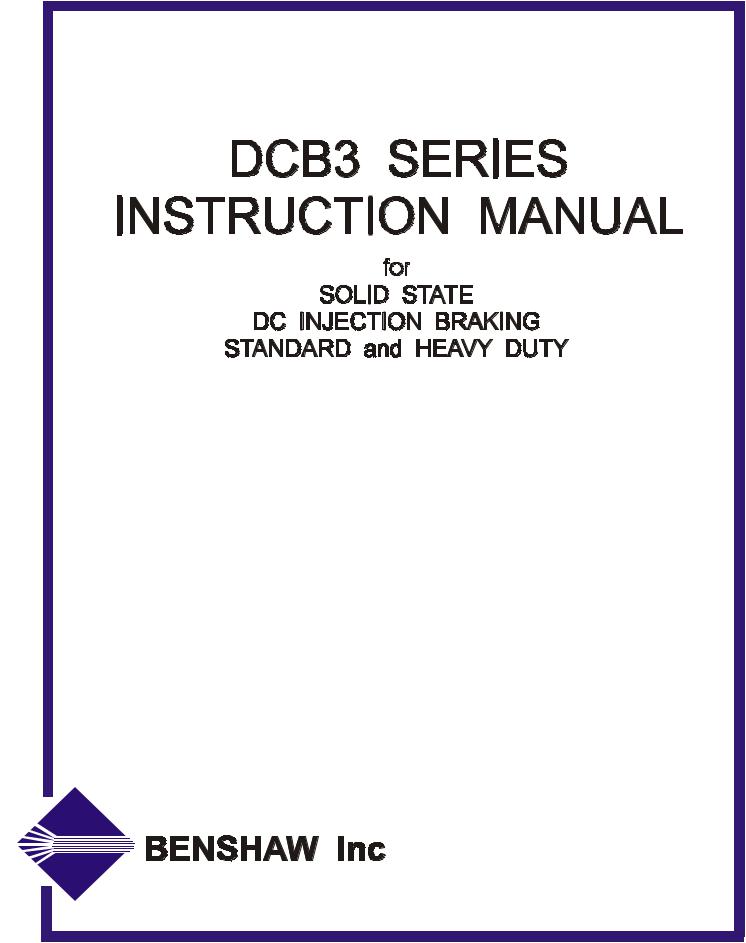Benshaw DCB3 Manual

890013-01-05

DCB3 SERIES
INSTRUCTION MANUAL
INDEX
TITLE |
PAGE |
PRE-START-UP INSPECTION |
2 |
GENERAL |
2 |
POWER ASSEMBLY TECHNICAL DATA |
2 |
OPTIONS |
3 |
ZERO SPEED RELAY CONTACTS |
3 |
CONNECTION PROCEDURES FOR |
4 |
DC INJECTION BRAKING |
|
USING POWER FACTOR CAPACITORS |
6 |
INDUCTION MOTOR TEMPERATURE MEASUREMENT |
6 |
PREVENTATIVE MAINTENANCE |
6 |
SPARE PARTS |
7 |
TROUBLESHOOTING |
8 |
1

DCB3 SERIES
INSTRUCTION MANUAL
PRE-START-UP INSPECTION
1.Clean out all metallic particles and foreign matter.
2.Check all connections for tightness. Use recommended procedure for aluminum conductors.
3.On high resistance ohmmeter scale check L1 to T1, T2. Repeat for L 2. Check all terminals to ground. All readings should be several megohms or more.
GENERAL
Benshaw DCB3 DC Injection Brakes are used to provide DC braking current for induction type AC motors while operating in conjunction with an external motor starter that has its own start/stop control. When the external motor starter removes power from the motor, the loss of AC voltage at the motor leads triggers the D.C. brake.
When activated, the brake provides an adjustable DC current to two leads of the motor (0-300% full load amperes (FLA) STD Duty, 0-500% heavy duty) which develops braking torque. This current is applied for a time period adjustable from one and one-half to thirty seconds. A normally closed brake aux contact is provided to prevent restarting of the motor while brake current is applied. The voltage on the third lead of the motor is sensed to detect when the motor reaches zero speed, turning off the D.C. brake and allowing the motor to be restarted. A "Time" adjustment limits the maximum time that the D.C. brake can be on. The stopping brake torque adjustment enables smooth motor deceleration to zero speed providing controlled stopping times. This adjustment procedure reduces hazards associated with coasting machinery, overhauling loads, etc.
Three sets of Form C contacts are provided for external use, one set signals operation of the brake, and the other two can indicate when the motor reaches zero speed. Optional features include an input for zero-speed sensing by a proximity switch, and two dry contact inputs; one for independent brake operation (useful for "anti-windmilling" on large fans, for example) and another to inhibit D.C. brake operation when desired. The PC board can also be modified to extend the max. brake time from 30 sec. to one minute.
POWER ASSEMBLY TECHNICAL DATA
Each DCB3 Brake contains SCRs which have a minimum peak inverse voltage (PIV) rating of two and one-half times the line-to-line AC voltage and a root mean square (RMS) current rating normally selected to be three times the full load continuous current to the motor.
DCB3 Brakes are rated to operate at the maximum DC current with a maximum ambient temperature of 40° C at an altitude of 6,500 feet (2,000 meters) above sea level. Derating of one and one-half percent per degree C above 40° C and one percent for every 330 feet (100 meters) above 3,300 feet, must be considered when applying DCB3 Brakes.
2
